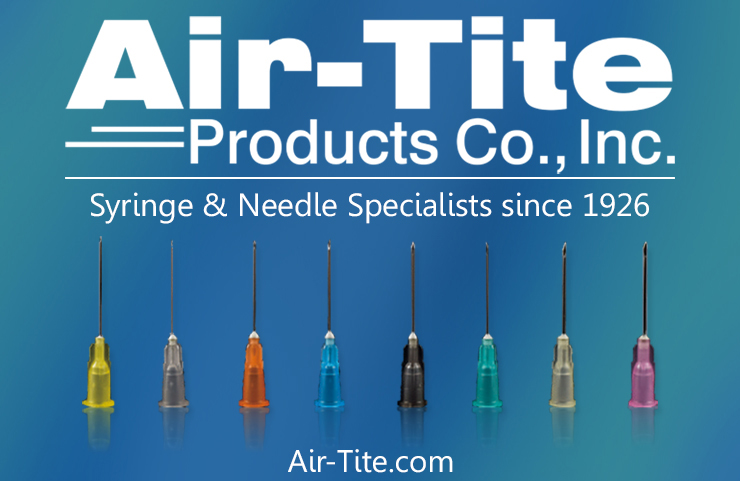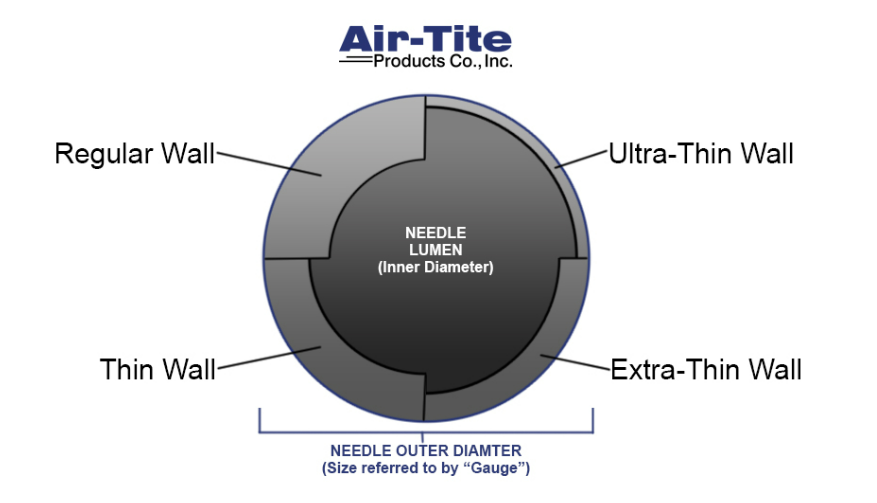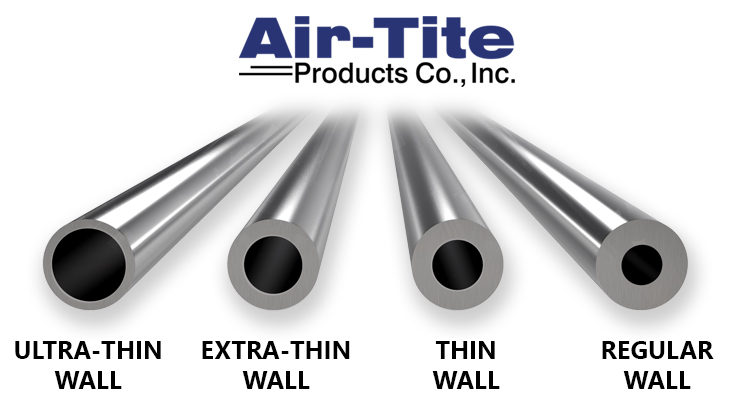
Understanding the inner and outer diameter of a needle is critical to choosing the right product for your specific application. You’ll also want to consider the gauge, length, needle wall type, and brand.
Needles come in various gauges, and their inner diameters can also vary depending if they have a(n):
These many factors can complicate the process of choosing the correct needle. Read on to learn more about the ins and outs of different needles.
The outer diameter refers to a needle’s gauge (abbreviated as “g”). The higher the gauge number, the smaller the outer diameter of the needle (and the thinner it appears). Smaller needle gauges help produce less bleeding and bruising, making injections more comfortable for patients.
A needle’s inner diameter describes the size of the needle’s lumen (the hollow bore that runs the length of a needle). Injectables have various consistencies, and thicker fluids cannot flow through smaller lumens. Because of this, viscous material passes more easily through a needle with a larger inner diameter.
Needles with larger lumens also offer a better flow rate and require less extrusion force, which is the amount of pressure needed to push the material through it.
The terms, “regular wall,” “thin wall,” “extra-thin wall,” and “ultra-thin wall” describe the thickness of the needle wall. Needle wall thickness is based on the inner and outer diameter. A needle’s gauge defines the thickness of the outside diameter. But the thickness of the needle wall itself can also vary (regular, thin, etc.), which affects the size of the lumen inside.

A thinner needle wall allows you to maximize flow rate while minimizing needle gauge size. This provides a more comfortable injection for the patient.
For example, 30g needles with an ultra-thin wall have a similar-sized lumen to:
On the other hand, a thicker needle wall provides additional sturdiness and stiffness. Due to the added thickness, long needles with a regular wall are less likely to flex than those with thinner walls. A thicker wall may also dull less quickly than a thinner-walled needle.

| Gauge | DESIGNATED METRIC SIZE (mm) | OUTER DIAMETER MIN (mm) | OUTER DIAMETER MAX (mm) | WALL TYPE | INNER DIAMETER MIN (mm) |
|---|---|---|---|---|---|
| 14 | 2.1 | 1.95 | 2.15 | Regular Thin Extra Thin |
1.500 1.600 1.727 |
| 15 | 1.8 | 1.75 | 1.9 | Regular Thin Extra Thin |
1.300 1.460 1.560 |
| 16 | 1.6 | 1.6 | 1.69 | Regular Thin Extra Thin |
1.100 1.283 1.390 |
| 17 | 1.4 | 1.4 | 1.51 | Regular Thin Extra Thin Ultra Thin |
0.950 |
| 18 | 1.2 | 1.2 | 1.3 | Regular Thin Extra Thin |
0.790 0.910 1.041 |
| 19 | 1.1 | 1.03 | 1.1 | Regular Thin Extra Thin Ultra Thin |
0.648 0.750 0.850 0.891 |
| 20 | 0.9 | 0.86 | 0.92 | Regular Thin Extra Thin Ultra Thin |
0.560 0.635 0.687 0.713 |
| 21 | 0.8 | 0.8 | 0.83 | Regular Thin Extra Thin Ultra Thin |
0.490 0.547 0.610 0.645 |
| 22 | 0.7 | 0.698 | 0.73 | Regular Thin Extra Thin |
0.390 0.440 0.522 |
| 23 | 0.6 | 0.6 | 0.673 | Regular Thin Extra Thin |
0.317 0.370 0.460 |
| 24 | 0.55 | 0.55 | 0.58 | Regular Thin |
0.280 0.343 |
| 25 | 0.5 | 0.5 | 0.53 | Regular Thin |
0.232 0.292 |
| 26 | 0.45 | 0.44 | 0.47 | Regular Thin |
0.232 0.292 |
| 27 | 0.4 | 0.4 | 0.42 | Regular Thin |
0.184 0.241 |
| 28 | 0.36 | 0.349 | 0.37 | Regular Thin |
0.133 0.190 |
| 29 | 0.33 | 0.324 | 0.351 | Regular Thin Extra Thin Ultra Thin |
0.133 0.190 0.240 0.265 |
| 30 | 0.3 | 0.298 | 0.32 | Regular Thin Extra Thin Ultra Thin |
0.133 0.165 0.190 0.240 |
| 31 | 0.25 | 0.254 | 0.267 | Regular Thin Extra Thin Ultra Thin |
0.114 0.125 0.146 0.176 |
| 32 | 0.23 | 0.229 | 0.241 | Regular Thin Extra Thin Ultra Thin |
0.089 0.105 0.125 0.146 |
| 33 | 0.2 | 0.203 | 0.216 | Regular Thin Extra Thin |
0.089 0.105 0.125 |
| 34 | 0.18 | 0.178 | 0.191 | Regular Thin Extra Thin |
0.064 0.091 0.105 |
At Air-Tite, we often hear questions regarding needle sizes such as:
However, these questions may not be specific enough to get the information you need to select the best product.
For instance, when asking which needle has the smallest diameter, it’s important to specify whether you’re referring to the inner needle diameter or outer needle diameter. The outer diameter (the gauge) reflects how thin the needle appears when viewed by the naked eye. But ultimately, the inner diameter varies based on needle wall thickness.
Additionally, by asking about the smallest needle, you could be referring to the smallest gauge or the shortest needle length. That’s why you must clarify the characteristics you’re inquiring about.
Fortunately, Air-Tite offers several options for those looking for super thin needles. THE INViSIBLE NEEDLE™ is the thinnest needle TSK Laboratory has ever made. At just 0.2mm in diameter, it’s 33% smaller than a 30 gauge needle, making it even smaller than a 33 gauge needle. THE INViSIBLE NEEDLE™ also features the product-saving Low Dead Space needle hub, differentiating it from other needles on the market.
Looking for additional options? Air-Tite offers 34 gauge standard hub needles from JBP in various lengths to suit your needs.
Understanding needle diameters and needle wall thicknesses help you make an informed purchase. At Air-Tite, we carry a wide range of needles, syringes, and associated products to ensure the best surgical experience and outcome. Click below to learn more.